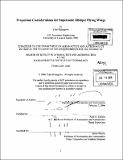| dc.contributor.advisor | Alan H. Epstein. | en_US |
| dc.contributor.author | Shinagawa, Yuto | en_US |
| dc.contributor.other | Massachusetts Institute of Technology. Dept. of Aeronautics and Astronautics. | en_US |
| dc.date.accessioned | 2007-01-10T16:39:39Z | |
| dc.date.available | 2007-01-10T16:39:39Z | |
| dc.date.copyright | 2006 | en_US |
| dc.date.issued | 2006 | en_US |
| dc.identifier.uri | http://hdl.handle.net/1721.1/35565 | |
| dc.description | Thesis (S.M.)--Massachusetts Institute of Technology, Dept. of Aeronautics and Astronautics, 2006. | en_US |
| dc.description | Includes bibliographical references (p. 111-113). | en_US |
| dc.description.abstract | Propulsion considerations unique to the supersonic oblique flying wing, including cycle selection, sizing, and integration were investigated via the development and interrogation of aerodynamic and propulsive synthesis models. These models were an amalgamation of computational tools (MSES), linearized theory, parametric estimation, and quasi D thermodynamic cycle analysis. Lift-to-drag ratio, thrust specific fuel consumption, and nacelle wave drag were examined as intermediate figures of merit that would ultimately impact the final performance metric-namely, range parameter and specific excess power. It was found that higher bypass ratio engines could yield an increase in the range parameter up until a critical mach number, above which the increasing nacelle drag would offset the TSFC reductions to yield a net degradation in range performance. Between the baseline TF30-type cycle and its BPR 2.4 modified variant, this critical mach number was found to be at approximately M 2.0 for TT4/TT2 = 5, and M 2.2 for TT4/TT2 = 6. | en_US |
| dc.description.abstract | (cont.) The OFW whose engine was sized for supersonic cruise was also found to have less excess power throughout the low speed regime and hence, longer climb and acceleration times than a comparable symmetric-wing supersonic aircraft. It was concluded that the OFW's reduced drag at supersonic cruise mitigates the gross oversizing of the engine that is common and inevitable for conventional supersonic aircraft at takeoff. Preliminary investigation of the turntable-mounted engine and slot-inlet have demonstrated their feasibility as viable engine integration concepts, but has also revealed the need for integrated design solutions, such as the development of a novel flat-top airfoil, aggressive S-ducts, and in general, a highly compact engine. | en_US |
| dc.description.statementofresponsibility | by Yuto Shinagawa. | en_US |
| dc.format.extent | 113 p. | en_US |
| dc.format.extent | 5967529 bytes | |
| dc.format.extent | 6487119 bytes | |
| dc.format.mimetype | application/pdf | |
| dc.format.mimetype | application/pdf | |
| dc.language.iso | eng | en_US |
| dc.publisher | Massachusetts Institute of Technology | en_US |
| dc.rights | M.I.T. theses are protected by copyright. They may be viewed from this source for any purpose, but reproduction or distribution in any format is prohibited without written permission. See provided URL for inquiries about permission. | en_US |
| dc.rights.uri | http://dspace.mit.edu/handle/1721.1/7582 | |
| dc.subject | Aeronautics and Astronautics. | en_US |
| dc.title | Propulsion considerations for supersonic oblique flying wings | en_US |
| dc.type | Thesis | en_US |
| dc.description.degree | S.M. | en_US |
| dc.contributor.department | Massachusetts Institute of Technology. Department of Aeronautics and Astronautics | |
| dc.identifier.oclc | 73828808 | en_US |
